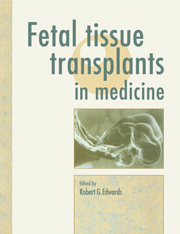Book contents
- Frontmatter
- Contents
- List of contributors
- Preface
- 1 Differentiation and transplantation of embryonic cells in mammals
- 2 Organogenesis and central nervous system development
- 3 Experimental human hematopoiesis in immunodeficient SCID mice engrafted with fetal blood-forming organs
- 4 Ontogeny of human T- and B-cell immunity
- 5 The procurement of human fetal tissues for clinical transplantation. Practice and problems
- 6 Transplantation of fetal haemopoietic and lymphopoietic cells in humans, with special reference to in utero transplantation
- 7 The biology of fetal brain tissue grafts: from mouse to man
- 8 Clinical results of transplanting fetal pancreas
- 9 The suitability of fetal and infantile donors for corneal transplantation
- 10 Transplantation of ovaries and testes
- 11 Cell grafting and gene therapy in metabolic diseases
- 12 The low temperature preservation of fetal cells
- 13 Law and ethics of transplanting fetal tissue
- Appendix: Code of practice on the use of fetuses and fetal material in research and treatment
- Brief bibliography on various aspects of transplanting fetal 337 tissue
- Index
6 - Transplantation of fetal haemopoietic and lymphopoietic cells in humans, with special reference to in utero transplantation
- Frontmatter
- Contents
- List of contributors
- Preface
- 1 Differentiation and transplantation of embryonic cells in mammals
- 2 Organogenesis and central nervous system development
- 3 Experimental human hematopoiesis in immunodeficient SCID mice engrafted with fetal blood-forming organs
- 4 Ontogeny of human T- and B-cell immunity
- 5 The procurement of human fetal tissues for clinical transplantation. Practice and problems
- 6 Transplantation of fetal haemopoietic and lymphopoietic cells in humans, with special reference to in utero transplantation
- 7 The biology of fetal brain tissue grafts: from mouse to man
- 8 Clinical results of transplanting fetal pancreas
- 9 The suitability of fetal and infantile donors for corneal transplantation
- 10 Transplantation of ovaries and testes
- 11 Cell grafting and gene therapy in metabolic diseases
- 12 The low temperature preservation of fetal cells
- 13 Law and ethics of transplanting fetal tissue
- Appendix: Code of practice on the use of fetuses and fetal material in research and treatment
- Brief bibliography on various aspects of transplanting fetal 337 tissue
- Index
Summary
THE TRANSPLANTATION of normal haemopoietic stem cells can cure a number of diseases in experimental animals as well as in humans. Stem cells, emerging from the yolk sac, migrate to the fetal liver and then to the bone marrow. In the latter two tissues, they develop in an appropriate microenvironment among a large variety of other cells. The bone marrow contains, in particular, T lymphocytes which developed in the thymus after this organ has been colonized by fetal liver or bone marrow prethymocytes and then returned back to the bone marrow or, to a lesser extent and only after the thirteenth week postfertilization, to the human fetal liver. Bone marrow transplantation (BMT) is a very effective treatment in many severe congenital disorders as well as in a number of inherited or acquired haematological diseases (Gatti et al, 1968; Koning et al, 1969; Thomas et al, 1975; Bortin & Rimm, 1977; Touraine et al., 1987).
Many patients have no HLA-identical donor available and the incompatible transplant is responsible for severe graft-versus-host disease (GvHD). Since GvHD is induced by the T lymphocytes which are present in the transplant and which react with host tissues (Grebe & Streilen, 1976; Korngold & Sprent, 1982), transplants from a donor who is not genotypically HLA-identical must be preceded by T cell depletion of the bone marrow. This manoeuvre reduces the incidence of GvHD but is associated with an increased risk of graft failure, incomplete reconstitution, EBV-induced lymphomas, or leukaemia relapse (O'Reilly et al, 1983; Fischer et al, 1986). It is therefore of considerable interest that fetal liver stem cells can reconstitute the haemopoietic and lymphopoietic systems of experimental animals and humans without severe GvHD, even in cases of full donor-host incompatibility (Bortin & Saltzstein, 1969; Lowenberg, 1975; Touraine, 1983;Prümmer et al, 1985;Champlinef et al., 1987; Touraine et al, 1987).
Since the pioneering work of Uphoff in 1958, much has been learned in the field of experimental and clinical fetal liver transplantation (FLT). Most of the studies have been carried out in mice (Lowenberg, 1975; Boersma, 1983). They have shown the effectiveness of fetal liver transplants in correcting the haematological and immunological consequences of lethal doses of irradiation (Uphoff, 1958; Lowenberg 1975; A. Aitouche & J.-L. Touraine, in preparation).
- Type
- Chapter
- Information
- Fetal Tissue Transplants in Medicine , pp. 155 - 176Publisher: Cambridge University PressPrint publication year: 1992



